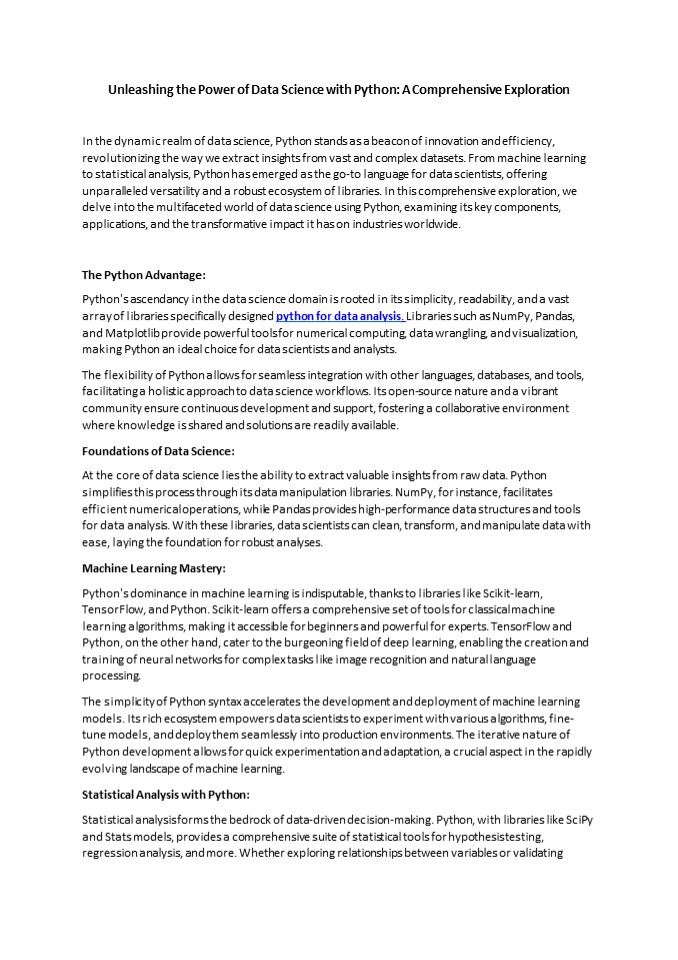Unleashing the Power of Data Science with Python A Comprehensive Exploration
Title:
Unleashing the Power of Data Science with Python A Comprehensive Exploration
Description:
Python's ascendancy in the data science domain is rooted in its simplicity, readability, and a vast array of libraries specifically designed python for data analysis. Libraries such as NumPy, Pandas, and Matplotlib provide powerful tools for numerical computing, data wrangling, and visualization, making Python an ideal choice for data scientists and analysts. The flexibility of Python allows for seamless integration with other languages, databases, and tools, facilitating a holistic approach to data science workflows. Its open-source nature and a vibrant community ensure continuous development and support, fostering a collaborative environment where knowledge is shared and solutions are readily available. –
Number of Views:3
Title: Unleashing the Power of Data Science with Python A Comprehensive Exploration
1
Unleashing the Power of Data Science with Python
A Comprehensive Exploration In the dynamic
realm of data science, Python stands as a beacon
of innovation and efficiency, revolutionizing
the way we extract insights from vast and complex
datasets. From machine learning to statistical
analysis, Python has emerged as the go-to
language for data scientists, offering
unparalleled versatility and a robust ecosystem
of libraries. In this comprehensive exploration,
we delve into the multifaceted world of data
science using Python, examining its key
components, applications, and the transformative
impact it has on industries worldwide. The
Python Advantage Python's ascendancy in the data
science domain is rooted in its simplicity,
readability, and a vast array of libraries
specifically designed python for data analysis.
Libraries such as NumPy, Pandas, and Matplotlib
provide powerful tools for numerical computing,
data wrangling, and visualization, making Python
an ideal choice for data scientists and
analysts. The flexibility of Python allows for
seamless integration with other languages,
databases, and tools, facilitating a holistic
approach to data science workflows. Its
open-source nature and a vibrant community
ensure continuous development and support,
fostering a collaborative environment where
knowledge is shared and solutions are readily
available. Foundations of Data Science At the
core of data science lies the ability to extract
valuable insights from raw data. Python
simplifies this process through its data
manipulation libraries. NumPy, for instance,
facilitates efficient numerical operations,
while Pandas provides high-performance data
structures and tools for data analysis. With
these libraries, data scientists can clean,
transform, and manipulate data with ease, laying
the foundation for robust analyses. Machine
Learning Mastery Python's dominance in machine
learning is indisputable, thanks to libraries
like Scikit-learn, TensorFlow, and Python.
Scikit-learn offers a comprehensive set of tools
for classical machine learning algorithms,
making it accessible for beginners and powerful
for experts. TensorFlow and Python, on the other
hand, cater to the burgeoning field of deep
learning, enabling the creation and training of
neural networks for complex tasks like image
recognition and natural language processing. The
simplicity of Python syntax accelerates the
development and deployment of machine learning
models. Its rich ecosystem empowers data
scientists to experiment with various algorithms,
fine- tune models, and deploy them seamlessly
into production environments. The iterative
nature of Python development allows for quick
experimentation and adaptation, a crucial aspect
in the rapidly evolving landscape of machine
learning. Statistical Analysis with
Python Statistical analysis forms the bedrock of
data-driven decision-making. Python, with
libraries like SciPy and Stats models, provides
a comprehensive suite of statistical tools for
hypothesis testing, regression analysis, and
more. Whether exploring relationships between
variables or validating
2
hypotheses, Python's statistical capabilities
empower data scientists to draw meaningful
conclusions from their data. Data
Visualization Communicating insights effectively
is paramount in data science, and Python excels
in data visualization through libraries like
Matplotlib, Seaborn, and Matplotlib offers a
versatile platform for creating static,
animated, or interactive visualizations. Seaborn,
built on top of Matplotlib, simplifies the
creation of aesthetically pleasing statistical
graphics. with its interactive capabilities,
enhances the storytelling aspect of data
visualization, enabling data scientists to create
compelling narratives around their findings.
Real-World Applications Data science using
Python finds applications across diverse
industries. In finance, predictive aids in risk
assessment and fraud detection. In healthcare,
machine learning algorithms patient data for
personalized treatment plans. Marketing benefits
from customer segmentation and targeted
advertising strategies derived from data
analysis. Python's adaptability ensures that its
applications are limited only by the imagination
of data scientists, making it an invaluable tool
in addressing real- world challenges. Challenges
and Future Trends While Python has undeniably
transformed the data science landscape,
challenges persist. Scalability and performance
bottlenecks may arise with large datasets,
necessitating optimization strategies. As
3
the field evolves, staying abreast of emerging
libraries, techniques, and ethical considerations
becomes crucial. The future promises continued
innovation in data science with Python.
Integration with cloud services, advancements in
natural language processing, and the evolution of
automated machine learning Auto ML are shaping
the next frontier. As Python continues to evolve,
so too will its impact on data science, paving
the way for ground breaking discoveries and
technological advancements. Conclusion In the
era of big data, Python stands tall as the
preeminent language for data science, empowering
practitioners to unlock valuable insights and
drive informed decision-making. From its
foundational libraries for data manipulation to
its advanced tools for machine learning and
visualization, Python provides a comprehensive
ecosystem for certified data scientists to
explore and communicate complex information. As
the data science landscape evolves, Python's
adaptability ensures its continued relevance,
making it an indispensable asset for
professionals and enthusiasts alike. Embracing
the power of data science with Python opens
doors to innovation, problem-solving, and a
deeper understanding of the world through the
lens of data.































